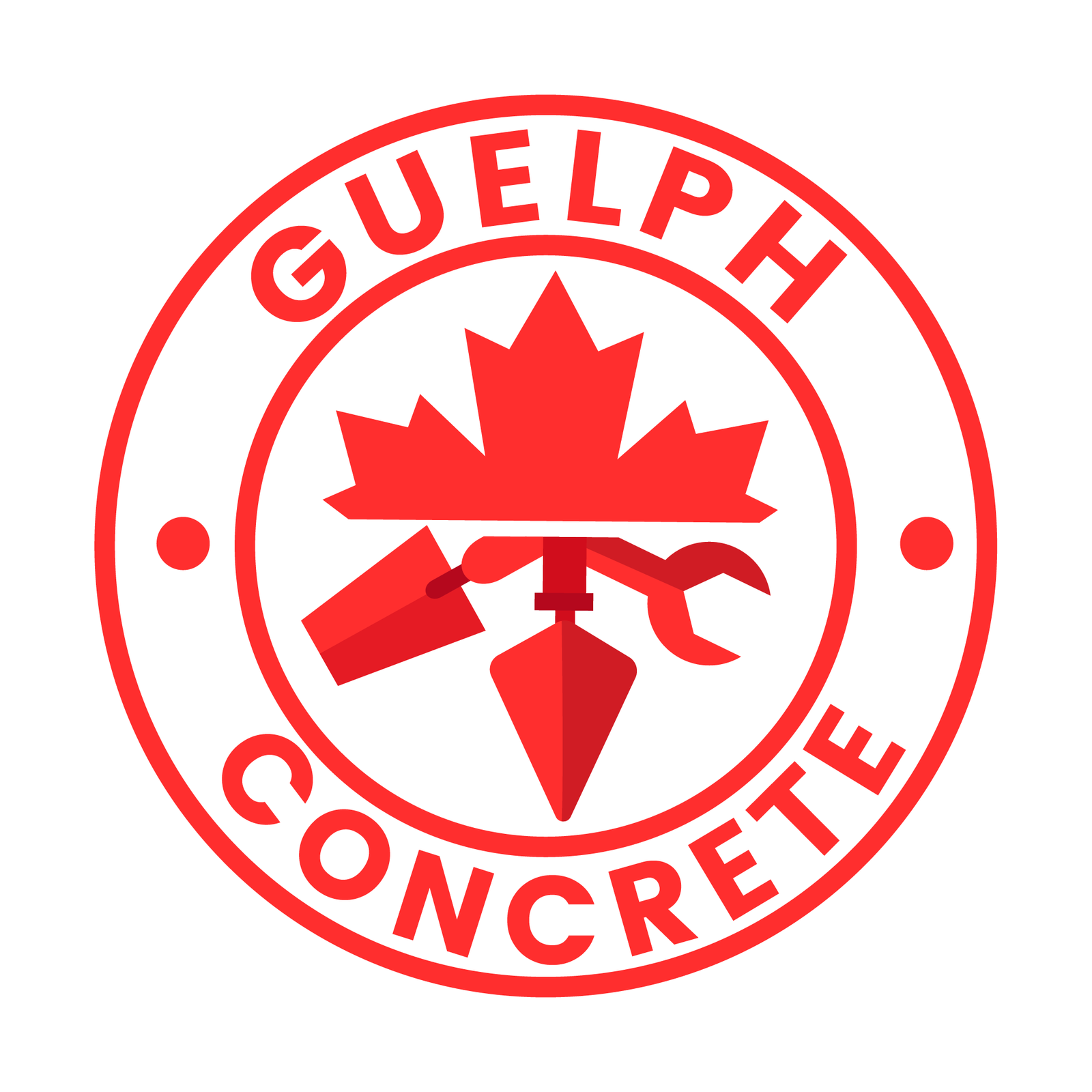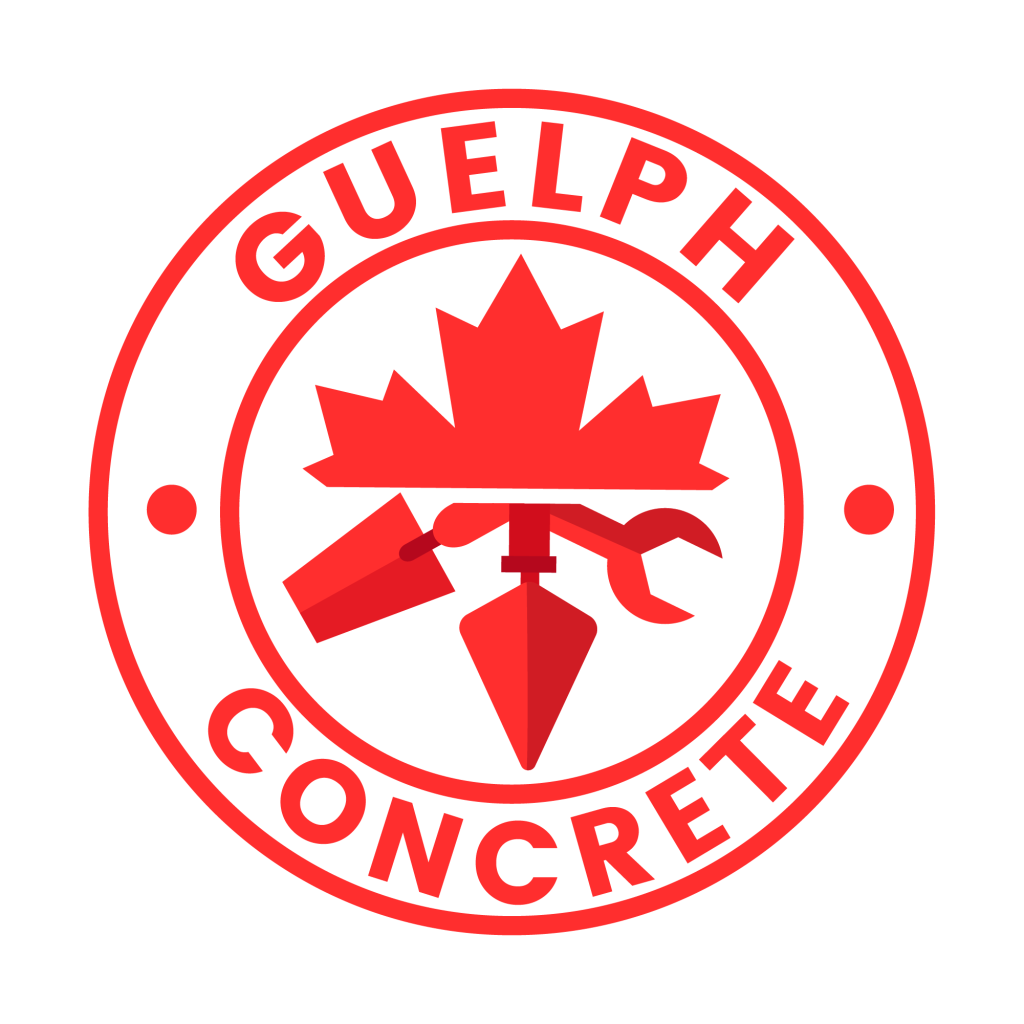At Guelph Concrete LTD, we understand the importance of maintaining a strong and waterproof stone foundation in Guelph, Ontario. With over 15 years of experience in the concrete industry, we’ve perfected our process to ensure your foundation remains sturdy and dry.
First, our team will thoroughly inspect your stone foundation for cracks and mortar erosion. We then carefully excavate around the foundation, ensuring stability and the appropriate depth.
Next, we clean the stones and reinforce mortar joints using high-quality materials for optimal durability.
To prevent water infiltration, we apply a waterproofing membrane from the bottom up, ensuring all edges are tightly sealed. For efficient drainage, we install weeping tiles below the footing.
We then backfill with gravel and ensure proper grading to direct water away from your foundation.
Regular maintenance is crucial to prolong the life of your foundation. We recommend annual inspections for cracks and cleaning your gutters to prevent water buildup.
If you’re looking for expert guidance and detailed steps on how to waterproof your stone foundation, contact Guelph Concrete LTD today. We offer free estimates and are here to help you protect your home. Call us at 548-490-2074 to get started!
Assessing Stone Foundation Condition
Before starting any waterproofing project, let’s first assess the condition of your stone foundation to pinpoint any areas needing repair. Conducting a thorough stone foundation assessment is vital to guarantee the structural integrity of your home, especially in the older homes of Guelph, Ontario.
We need to look for signs of mortar deterioration, moisture erosion, and any stone movement. These issues can become serious if left unchecked, potentially leading to more extensive damage.
The significance of professional inspection can’t be emphasized enough. While we might feel confident taking on a DIY approach, a trained eye will spot problems that we might overlook. Professionals can identify subtle signs of wear and tear that are easy to miss, and they’ve the expertise to recommend the best course of action.
That said, there are still some DIY solutions we can undertake, like visually inspecting the foundation for obvious cracks or gaps and noting any areas where water might be seeping through.
Addressing these problems early on will save us time and money in the long run. By guaranteeing our stone foundation’s structural integrity, we’re laying the groundwork for an effective waterproofing strategy.
Excavation Around the Foundation
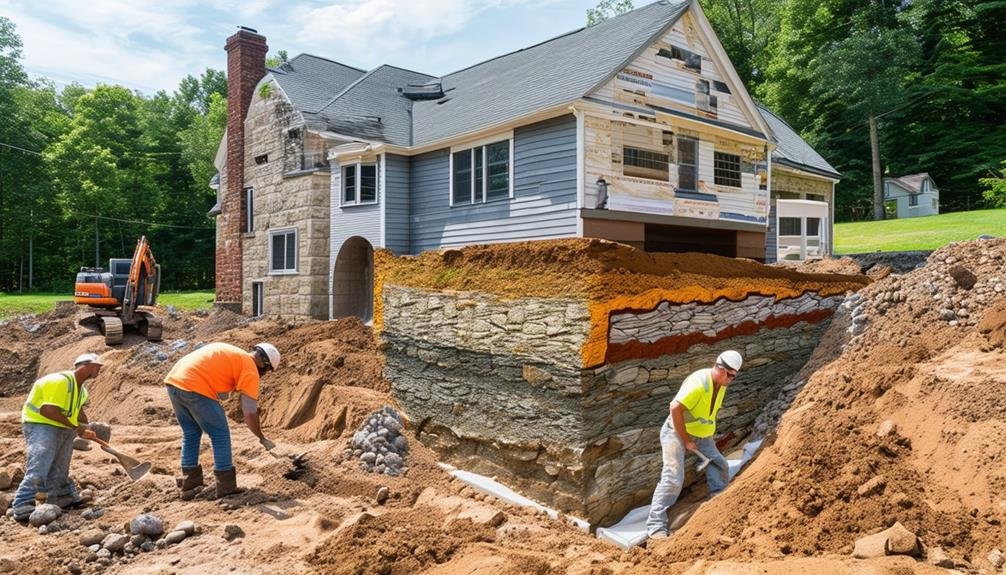
Let’s start by carefully digging around the stone foundation to uncover the surfaces that need waterproofing. This step is vital for effective waterproofing and securing the longevity of your foundation. We must take several excavation precautions to maintain foundation stability and avoid any structural damage.
Firstly, let’s make sure that the excavation depth is appropriate. We want to dig deep enough to access the entire foundation wall but not so deep that we compromise the foundation’s stability. Typically, a depth of 3 to 4 feet is sufficient.
Next, we’ll follow these steps to ensure our excavation is thorough and safe:
- Measure and Mark: Clearly mark the area around the foundation to guide our excavation and guarantee consistent depth.
- Gradual Digging: Use shovels and small excavators to slowly dig around the foundation, avoiding heavy machinery that might damage the stone structure.
- Inspect Frequently: Regularly inspect the exposed foundation for any existing issues or potential waterproofing challenges.
Cleaning and Mortar Reinforcement
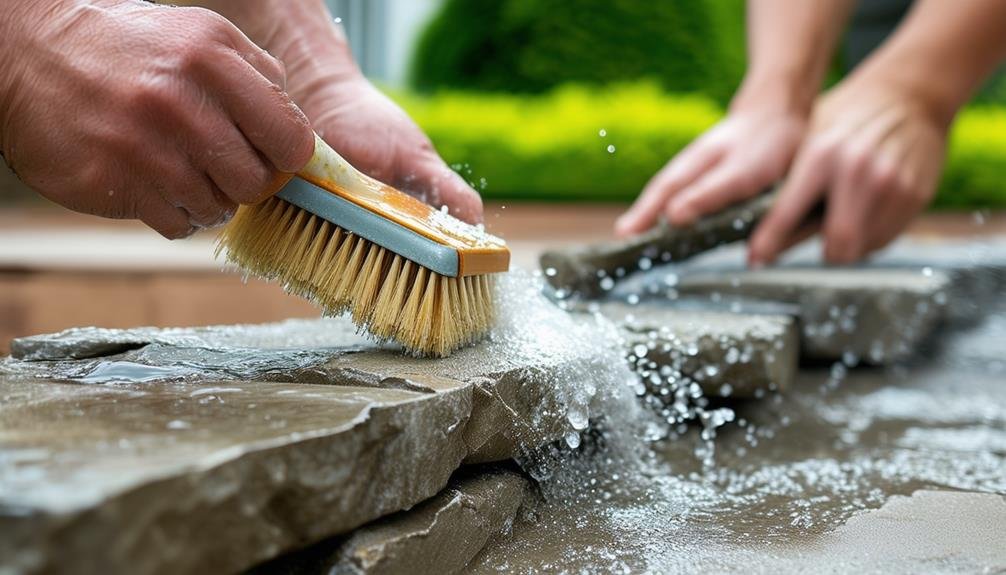
First, we’ll thoroughly clean the stone foundation to remove any dirt, debris, and old mortar, securing a solid base for our waterproofing efforts. This step is essential; it prepares the surface for effective stone restoration and masonry repair. We’ll use wire brushes, pressure washers, and possibly mild detergents, making sure every crevice is free of loose material.
Once the foundation is clean, we’ll address the mortar reinforcement. Carefully applying new mortar to fill gaps and cracks between stones is necessary. This process, known as repointing, won’t only enhance the bond between stones but also improve the structure’s overall durability. We’ll use high-quality, specialized products designed specifically for stone foundation repair. These products are formulated to resist water penetration, securing the longevity of our efforts.
Next, we’ll seal any visible cracks or openings with a waterproof sealant. This step is crucial to prevent moisture from seeping into the foundation, which could undermine our previous work. Regular maintenance and inspection of the mortar and sealant will be necessary to maintain the waterproofing effectiveness.
Applying Waterproofing Membrane
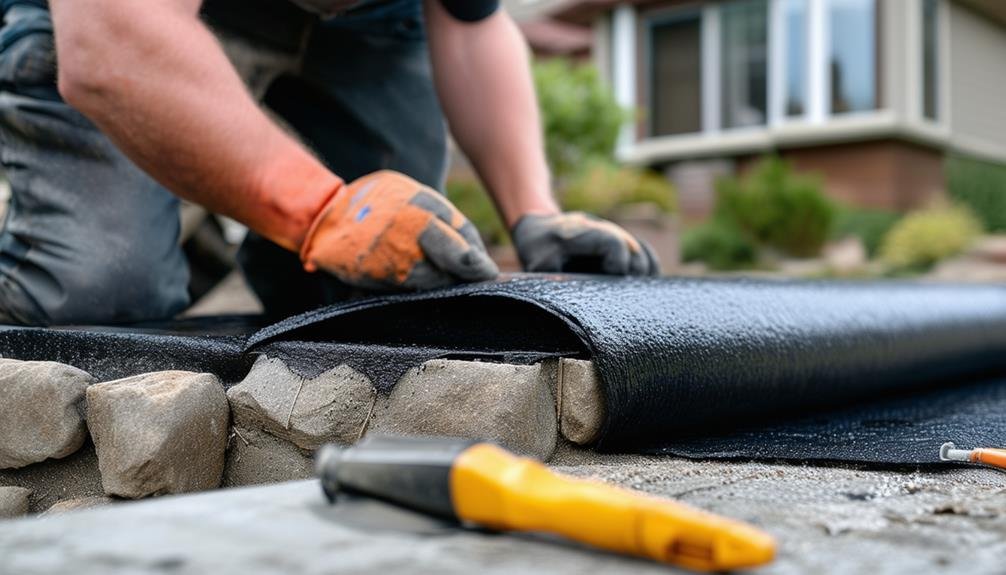
Applying a waterproofing membrane is a critical step in guaranteeing our stone foundation remains impervious to moisture and the elements. To achieve a watertight seal, we need to follow specific best practices for membrane application. First, make sure the foundation surface is clean and dry; any dirt or moisture can compromise the membrane’s adhesion. Next, apply a primer if recommended by the membrane manufacturer to enhance stickiness.
Here are three key steps to guide us:
- Measure and Cut the Membrane: Accurately measure the foundation walls and cut the membrane to size, allowing for a bit of overlap.
- Apply the Membrane: Starting from the bottom, press the membrane firmly onto the wall, smoothing out air bubbles and wrinkles as you go. Use a roller to guarantee strong adhesion.
- Seal the Edges: Pay special attention to corners and edges, guaranteeing they’re tightly sealed to prevent water ingress.
Common mistakes include not properly preparing the surface, leading to poor adhesion, and failing to overlap seams adequately, which can allow water to seep through. Troubleshooting tips involve revisiting these areas if issues arise and reapplying the membrane where necessary.
Installing Weeping Tile Drainage
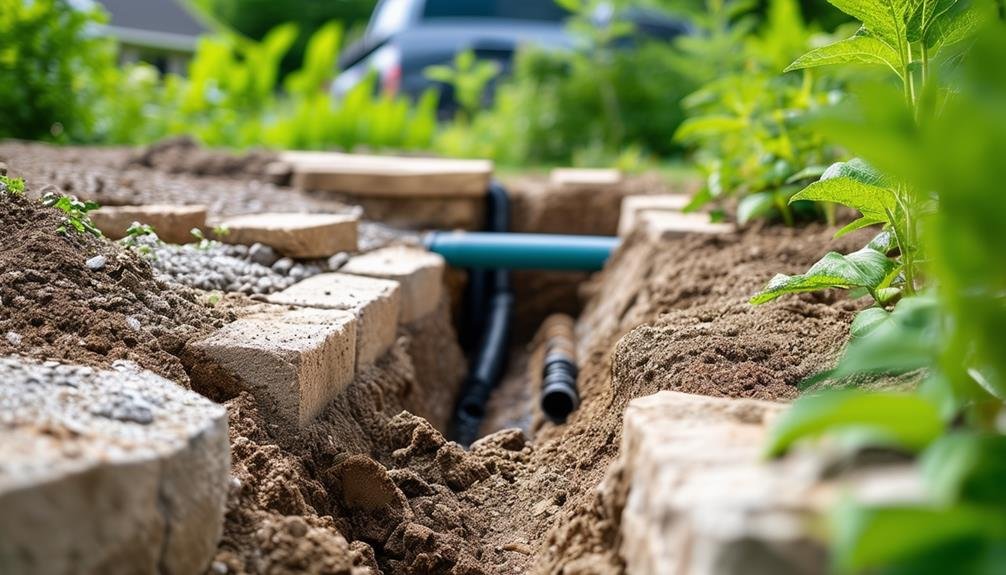
Properly installing weeping tile drainage is crucial for ensuring our stone foundation remains dry and protected from groundwater. Weeping tile systems, installed below the footing, efficiently collect and remove water, channeling it to an interior sump pit. This setup is essential for effective water management and long-term foundation health.
Weeping tile benefits are numerous—preventing hydrostatic pressure buildup, reducing basement moisture, and safeguarding our home’s foundation integrity. Maintenance is fairly straightforward: regular inspections and occasional flushing guarantee the system remains clog-free and functional.
There are drainage system alternatives, but they often come with varying costs and effectiveness. French drains, for instance, can be an option, but they might not offer the same level of protection for stone foundations as weeping tiles. Choosing the right system depends on our specific needs and budget.
Here’s a quick comparison to help guide our decision-making:
| Feature | Weeping Tile Benefits | French Drain Alternatives |
|---|---|---|
| Efficiency | High | Moderate |
| Installation Costs | Moderate | Low to Moderate |
| Maintenance | Low | Moderate |
| Longevity | Long-lasting | Varies |
Sump Pump System Setup

Setting up a reliable sump pump system is vital for managing water buildup and protecting our stone foundation basement from potential flooding. To start, we must guarantee the sump pump is properly installed and connected to a weeping tile system for effective drainage.
Here’s a practical guide to get it right:
- Install the Sump Pit and Pump: Dig a sump pit at the lowest point of our basement. Place the sump pump inside, ensuring it’s level and securely positioned. Connect it to the weeping tile system to direct water into the pit.
- Pump Maintenance: Regular maintenance is essential to keep the system functioning at its best. Check the pump periodically for debris, test the float switch, and confirm the discharge line is clear. A well-maintained pump prevents unexpected flooding and extends its lifespan.
- Backup Options: Power outages can render our sump pump useless during a storm. Consider adding a battery backup system to keep the pump operational when we need it most. Alternatively, a water-powered backup pump is another dependable option.
Backfilling and Grading
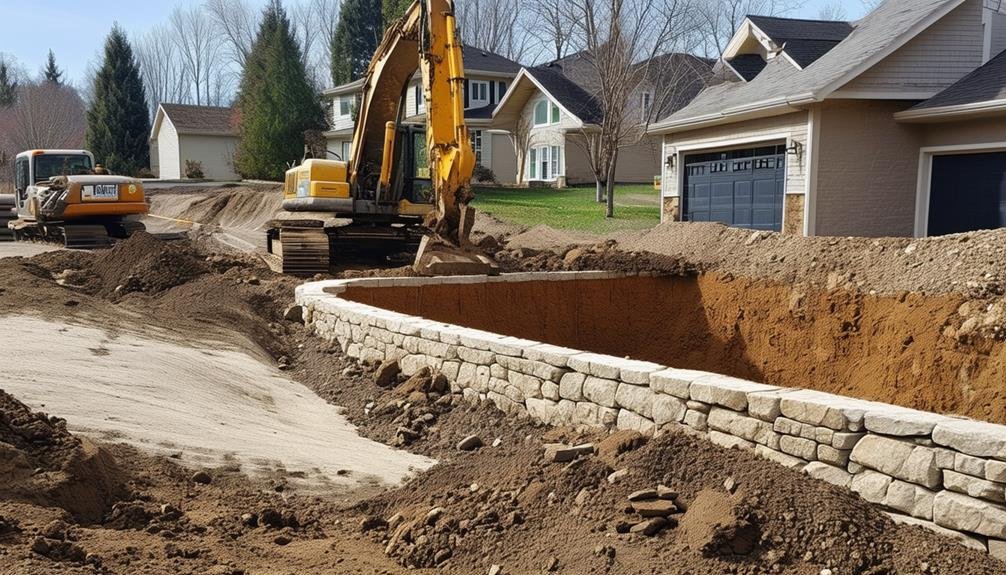
At Guelph Concrete LTD, with over 15 years of experience serving Guelph, Ontario, we understand the importance of backfilling and grading in keeping your stone foundation dry. Proper soil compaction and ensuring the ground slopes away from the house are essential to promote effective water drainage. By using quality materials and employing the best techniques, we can significantly reduce the risk of water infiltration.
Contact Guelph Concrete LTD today for a free estimate.
Let’s help you protect your home with our expert backfilling and grading services.
Call us at 548-490-2074.
Proper Soil Compaction
When it comes to backfilling and grading around a stone foundation, ensuring the soil is compacted properly is key to maintaining its waterproof integrity. Proper soil compaction brings several benefits, such as preventing settling and shifting, which can compromise our foundation’s waterproofing. It also helps maintain proper drainage and avoids water buildup near the foundation.
We need to be aware of different compaction methods to achieve the best results. Here’s a quick rundown:
- Mechanical Compaction: Using tools like plate compactors or rollers to mechanically compress the soil.
- Water Settling: Adding water to soil layers, allowing it to settle and compact naturally.
- Manual Compaction: Using hand tools like tampers for smaller areas or delicate spots.
Each method has its pros and cons. Mechanical compaction is fast and effective, especially for large areas. Water settling is less labor-intensive but takes longer and can be tricky to control. Manual compaction, while laborious, offers precision for tight spots.
Effective Water Drainage
To keep our stone foundation dry and stable, we must focus on effective water drainage through strategic backfilling and grading. Proper backfilling around the foundation prevents water accumulation and seepage into the basement. Using gravel or crushed stone improves drainage, ensuring water doesn’t collect around the foundation walls.
Next, we need to divert water away from the structure. This is where grading comes into play. By sloping the soil away from the foundation, we reduce the risk of moisture issues significantly. An important drainage solution to contemplate is the installation of weeping tiles or French drains. These systems efficiently redirect water away from the foundation, forming a crucial part of our waterproofing methods.
Here’s a quick guide to effective water drainage:
| Task | Benefit |
|---|---|
| Backfilling with gravel | Enhances drainage, prevents water pooling |
| Proper grading | Directs water away from foundation |
| Installing weeping tiles | Redirects water away, reduces moisture risk |
| Using French drains | Efficient water diversion, part of waterproofing methods |
Grading Techniques Explained
How can we effectively manage water flow around our stone foundation to prevent damage and guarantee longevity? Let’s explore grading techniques, which play an essential role in foundation waterproofing and maintaining the safety and dryness of our homes in Guelph, Ontario.
First, backfilling with the right materials is necessary. We should be using granular materials like gravel, which promote proper drainage solutions by directing water away from the foundation walls. This prevents water from pooling and causing harm.
Second, let’s not overlook the significance of soil compaction and proper grading. The soil around our foundation should be sloped away at a minimum of 6 inches for the first 10 feet. This simple landscaping tip helps ensure water doesn’t saturate the soil around the foundation.
Third, installing gutters and downspouts is essential. To make this even more efficient, we can add extensions to our downspouts to discharge water at least 5-10 feet away from the foundation.
Here’s a quick checklist:
- Backfill with gravel – Ensures proper drainage.
- Grade soil away from foundation – Minimum 6 inches for the first 10 feet.
- Install and extend downspouts – Direct water 5-10 feet away.
Routine Maintenance Tips
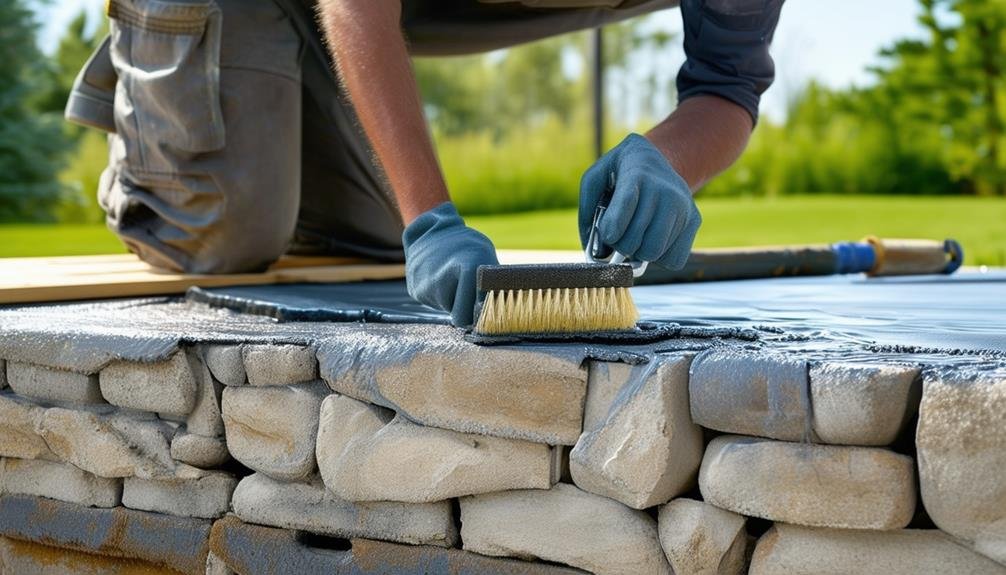
Why don’t we start by regularly examining the stone foundation for cracks, erosion, or signs of water penetration? Taking preventive measures can save us from costly repairs down the line. Developing a maintenance schedule guarantees that we catch small issues before they become big problems. Here are some practical tips to help maintain our stone foundation:
- Inspect Regularly: Check for cracks and erosion.
- Clean Gutters: Keep them free from debris.
- Ensure Proper Grading: Direct water away from the foundation.
| Task | Recommended Frequency |
|---|---|
| Inspect foundation | Every 6 months |
| Clean gutters | Quarterly |
| Check grading | Annually |
For minor cracks and erosion, DIY repairs might be sufficient. Using waterproof sealants or coatings can be an effective way to protect the stone foundation. However, for more significant issues, professional services should be considered to guarantee the job is done right.
Addressing drainage issues promptly is another critical step in our maintenance routine. Water pooling near the foundation can lead to serious damage, so let’s remain vigilant and proactive. By following these tips, we can keep our stone foundation in Guelph, Ontario, in excellent condition for years to come.
Choosing the Right Contractor
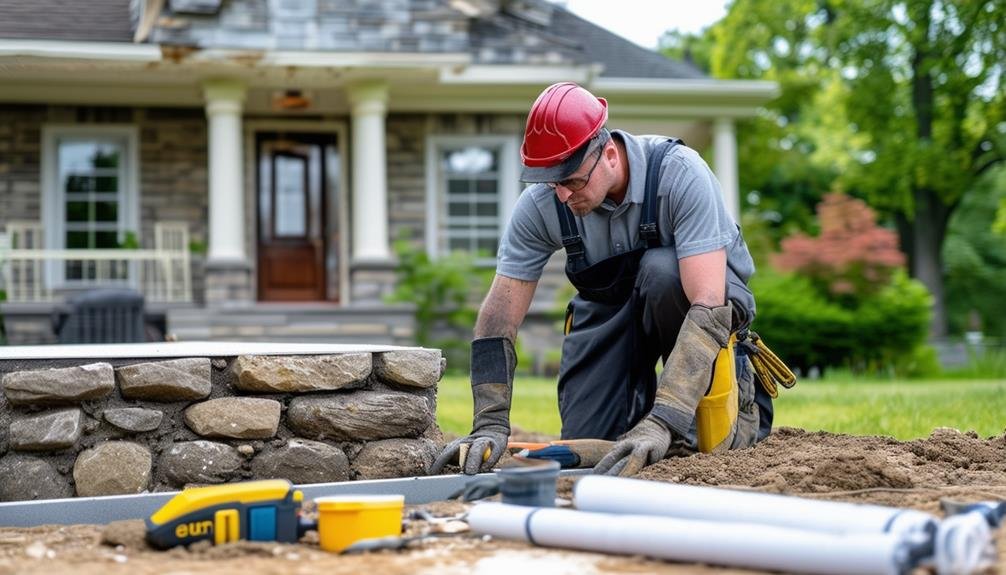
Selecting the appropriate contractor for waterproofing our stone foundation in Guelph, Ontario, means focusing on experience, specialization, and customer feedback.
First off, we need to confirm the contractor has extensive experience specifically with stone foundations. This guarantees they’ll use the right waterproofing techniques that suit our unique situation.
Next, we should look into their contractor qualifications. Certifications are a must; they show that the contractor knows what they’re doing and meets industry standards. Let’s also consider the warranties offered. A good warranty not only provides peace of mind but also signifies confidence in their work.
Customer reviews can make or break our decision. Honest feedback from previous clients will give us a clear picture of the contractor’s reliability and quality of service.
Here’s a practical approach to choosing the right contractor:
- Check Qualifications and Certifications: Confirm they’ve the necessary credentials.
- Evaluate Waterproofing Techniques and Warranties: Look for specialized techniques and robust warranties.
- Read Customer Reviews: Learn from the experiences of others to gauge the contractor’s reputation.
Frequently Asked Questions
Can a Stone Foundation Be Waterproofed?
Yes, we can definitely waterproof a stone foundation. Stone foundation maintenance is important, and using waterproofing techniques like applying waterproof coatings and installing drainage systems will keep our basements dry and our structures sound.
What Do You Use to Seal a Stone Foundation?
We once used a high-quality waterproofing product like Drylok to seal a stone foundation. Cleaning and repairing cracks first, we applied multiple coats using top sealing techniques, ensuring long-lasting protection. Regular maintenance is key.
What Is the Best Way to Waterproof a Foundation?
We should consider exterior sealants and effective drainage solutions. Interior waterproofing techniques also help. Consulting professional services guarantees we address every aspect. Together, we can protect our foundations and homes from water damage, creating a safe, dry space.
How Do You Preserve Stone Foundation?
To maintain a stone foundation, we should focus on preservation methods like repairing cracks, resetting stones, and reinforcing with new mortar. These long term solutions guarantee the foundation stays strong and durable for years to come.
Conclusion
In wrapping up, waterproofing a stone foundation in Guelph isn’t just a small task—it’s a monumental achievement that guarantees your home stays dry and secure.
By following these steps and staying proactive with maintenance, we can protect our investment for years to come.
Don’t cut corners and always choose a reputable contractor. Your foundation will thank you, and you’ll sleep easier knowing you’ve built a fortress against the elements.
